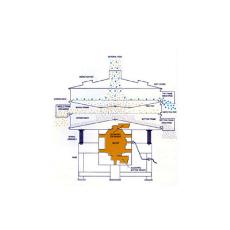Product Profile of Industrial Grade Vibro Screen
Industrial Grade Vibro Screen has the feature that by varying the angular displacement of the bottom eccentric weight, the screening pattern can be optimised for each job, thus giving a high capacity per square foot of screen surface. The Vibro Screen is designed in such a manner that discharge ports can be rotated to meet layout requirements and individual frames between screen decks can be tailored to suit the needs of that fraction. The Vibro Screen ensures that motion is transmitted through the screening assembly and vibration is completely absent from the screen base and no special foundations are required and many screens are operating suspended from ceiling hangers. The Vibro Screen finds application in process industry, pulp and paper mill, sugar mill, food industry, screening of turmeric pigment, chemical industry, screening of cotton stem chip, removal of coarse fibres from paper mill effluent, screening of refractory grog, screening of coconut shell powder and rubber particles. The Industrial Grade Vibro Screen has the feature that the material is fed on to the centre of the top screen and the oversize material is moved by the multi-plane motion to the periphery of the screen to be discharged through a tangential outlet and the undersize particles and liquids pass through the screen to produce fine sized fractions or clarified liquid.
Application of Industrial Grade Vibro Screen:
- Screening of ground almonds.
- Screening of coconut shell powder
- Screening of maida flour.
- Screening of papaya cubes.
- Screening of soya and maida flour, dry potato powder
Screening of starch powder.
- Separation of waste threads, jute, coriander seeds etc from sugar granules
- Screening of turmeric pigment
- Screening of refined table salt.
- Separation of solid fat from ghee
- Clarification of alkaline extracts of soya flakes
- Screening of castor seed extraction
- Citrus skin/ oil and water emulsion
- Removal of broken pellets from pelletiser.
- Clarification of fermented maize slurry.
- Clarification of steeping press liquor
- Screening of crimson paint.
- Screening of backwater from paper-mill.
- Screening of cotton stem chip.
- Removal of coarse fibres from paper mill effluent
- Screening of refractory grog.
- Screening of coconut shell powder
- Screening of crushed silica sand.
- Screening of polyester chips to remove strands.
Key Features of Industrial Grade Vibro Screen
- By varying the angular displacement of the bottom eccentric weight, the screening pattern can be optimised for each job, thus giving a high capacity per square foot of screen surface.
- Discharge ports can be rotated to meet layout requirements and individual frames between screen decks can be tailored to suit the needs of that fraction.
- Motion is transmitted through the screening assembly and vibration is completely absent from the screen base and no special foundations are required and many screens are operating suspended from ceiling hangers.
- The material is fed on to the centre of the top screen and the oversize material is moved by the multi-plane motion to the periphery of the screen to be discharged through a tangential outlet and the undersize particles and liquids pass through the screen to produce fine sized fractions or clarified liquid.
- The tangential component of the motion imparted to the solid on the screen is controlled by the angular position of the top and bottom eccentric weights
- The screening pattern can therefore be controlled by altering the angle of the eccentrics and some general examples of the type of control are shown in the diagram below.
- The material is fed on to the centre of the top screen and the oversize material is moved by the multi-plane motion to the periphery of the screen to be discharged through a tangential outlet and the undersize particles and liquids pass through the screen to produce fine sized fractions or clarified liquid.
